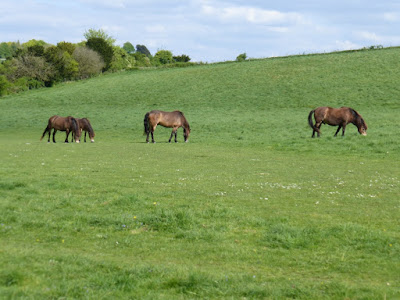From Winchester we headed toward Stoarhead, our next home and garden, but missed a turn and found ourselves on single-lane roads
way out in the fields. Readjusting Garmina, our crack satnav, we made for Sarum, hoping to find larger roads. Eventually, I saw a sign for Danbury Hillfort, and we decided to call it a night, way out in the boonies, at a quiet lay-by just short of the ancient site. In 2009 and in 2013, we always had good wild-camping luck with archaeological sites. They and their carparks are generally deserted, except for the really big ones, and certainly so after dark.
 |
Next morning we drove up to the site; which turned out to be
anything but deserted on a fine Sunday morning |
 |
| Thus; cleverly camoflouged as a forested hill |
 |
Just east of The Wallops, Over Wallop, Middle Wallop,
and Nether Wallop; Wallop itself was destroyed by
bombardment in the Civil War; hence the origin of the
expression "walloped" |
 |
| The view from atop Danebury Hillfort |
 |
The site is amply explained in a variety of signs, provided by
the Hampshire County Council; Danebury was excavated
extensively by Oxford archaeologists in the 70s and 80s; the
gist is that it is Iron Age, built about 500 BC, occupied
continuously by some 300-400 people for 400-500 years, then
abandoned; Britain has more than a thousand such hillforts;
seven other hillforts can be seen (by the experienced eye) from
Danebury |
 |
Good view of the ditch and rampart that surround the site; even
after a couple thousand years' erosion, in a very wet and windy
climate, the rampart is often 20-30 feet above the ditch |
 |
| Walking the rampart, which encloses about 5 hectares |
 |
| Thus |
 |
A bit of the double gate entrance scheme; if invaders get through
the initial gate, they enter a killing field; among the artifacts
found were a hoard of 11,000 sling stones; also 180,000 pottery
shards...we always wonder who got to count the pottery shards
and how accurate the count actually was... |
 |
| One of the Wallops |
 |
| Round enclosure marking the site of |
 |
One of the round houses, used for human habitation; the
inhabitants farmed and raised sheep and cattle; and traded
"Keep Calm..." merchandise |
 |
They are nevertheless part of the Hampshire County Council
seal |
 |
| Another view of the formidable ditch and rampart system |
 |
A path leading into the enclosure...note the tiny
white daisy-like flowers...they grow only on the
established paths |
 |
| Thus |
 |
The upper carpark, space for 30 or so cars, was full throughout
the day, many of the visitors dog-walkers |
 |
But also many family outings, picnics, kite-flyings, and other
activities
|
 |
One wonders how much thought is given to the place and to
one's ancestors, however distant |






























































